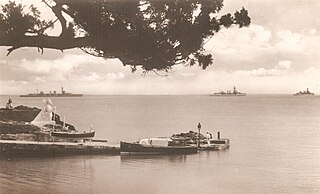
The North America and West Indies Station was a formation or command of the United Kingdom's Royal Navy stationed in North American waters from 1745 to 1956, with main bases at the Imperial fortresses of Bermuda and Halifax, Nova Scotia. The North American Station was separate from the Jamaica Station until 1830 when the two combined to form the North America and West Indies Station. It was briefly abolished in 1907 before being restored in 1915. It was renamed the America and West Indies Station in 1926. It was commanded by Commanders-in-Chief whose titles changed with the changing of the formation's name, eventually by the Commander-in-Chief, America and West Indies Station.

Sink the Bismarck! is a 1960 black-and-white CinemaScope British war film based on the 1959 book The Last Nine Days of the Bismarck by C. S. Forester. It stars Kenneth More and Dana Wynter and was directed by Lewis Gilbert. To date, it is the only film made that deals directly with the operations, chase and sinking of the battleship Bismarck by the Royal Navy during the Second World War. Although war films were common in the 1960s, Sink the Bismarck! was seen as something of an anomaly, with much of its time devoted to the "unsung back-room planners as much as on the combatants themselves". Its historical accuracy, in particular, met with much praise despite a number of inconsistencies.

Admiral of the Fleet Sir Arthur Knyvet Wilson, 3rd Baronet, was a Royal Navy officer. He served in the Anglo-Egyptian War and then the Mahdist War being awarded the Victoria Cross during the Battle of El Teb in February 1884. He went on to command a battleship, the torpedo school HMS Vernon and then another battleship before taking charge of the Experimental Torpedo Squadron. He later commanded the Channel Fleet. He briefly served as First Sea Lord but in that role he "was abrasive, inarticulate, and autocratic" and was really only selected as Admiral Fisher's successor because he was a supporter of Fisher's reforms. Wilson survived for even less time than was intended by the stop-gap nature of his appointment because of his opposition to the establishment of a Naval Staff. Appointed an advisor at the start of World War I, he advocated offensive schemes in the North Sea including the capture of Heligoland and was an early proponent of the development and use of submarines in the Royal Navy.
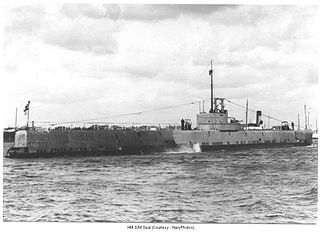
HMS Seal was one of six Grampus-class mine-laying submarines of the Royal Navy. She served in the Second World War and was captured by the Kriegsmarine and taken into German service as UB, one of several captured subs. She was the only submarine the Germans captured at sea during World War II. Her capture allowed the Germans to correct a critical fault in their U-boat torpedoes.

The Commander-in-Chief, The Nore, was an operational commander of the Royal Navy. His subordinate units, establishments, and staff were sometimes informally known as the Nore Station or Nore Command. The Nore is a sandbank at the mouth of the Thames Estuary and River Medway. In due course the Commander-in-Chief became responsible for sub-commands at Chatham, London, Sheerness, Harwich and the Humber.

HMD Bermuda was the principal base of the Royal Navy in the Western Atlantic between American independence and the Cold War. The Imperial fortress colony of Bermuda had occupied a useful position astride the homeward leg taken by many European vessels from the New World since before its settlement by England in 1609. French privateers may have used the islands as a staging place for operations against Spanish galleons in the 16th century. Bermudian privateers certainly played a role in many English and British wars following settlement, with its utility as a base for his privateers leading to the Earl of Warwick, the namesake of Warwick Parish, becoming the most important investor of the Somers Isles Company. Despite this, it was not until the loss of bases on most of the North American Atlantic seaboard threatened Britain's supremacy in the Western Atlantic that the island assumed great importance as a naval base. In 1818 the Royal Naval Dockyard, Bermuda officially replaced the Royal Naval Dockyard, Halifax, as the British headquarters for the North America Station (which would become the North America and West Indies Station after absorbing the Jamaica Station in 1830.
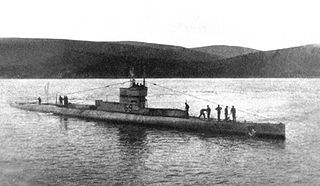
HMS G9 was a G-class submarine, one of eight Royal Navy submarines known to have been lost to friendly fire in World War I.

HMS Spiteful was a Spiteful-class torpedo boat destroyer built at Jarrow, England, by Palmers Shipbuilding and Iron Company for the Royal Navy and launched in 1899. Specified to be able to steam at 30 knots, she spent her entire career serving in the seas around the British Isles.
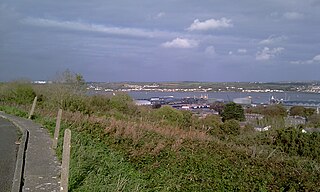
Pembroke Dockyard, originally called Pater Yard, is a former Royal Navy Dockyard in Pembroke Dock, Pembrokeshire, Wales.
Captain Stephen Wentworth Roskill, was a senior career officer of the Royal Navy, serving during the Second World War and, after his enforced medical retirement, served as the official historian of the Royal Navy from 1949 to 1960. He is now chiefly remembered as a prodigious author of books on British maritime history.

Admiral of the Fleet Sir Charles Edward Lambe, was a senior Royal Navy officer. He fought in the Second World War in command of a cruiser, as Director of Naval Plans and then in command of an aircraft carrier. He served as First Sea Lord and Chief of the Naval Staff from 1959 until 1960 when he was forced to retire early because of a heart condition. He died only a few months later.
Admiral Sir Robert Spencer Robinson, was a British naval officer, who served as two five-year terms as Controller of the Navy from February 1861 to February 1871, and was therefore responsible for the procurement of warships at a time when the Royal Navy was changing over from unarmoured wooden ships to ironclads. As a result of the Captain disaster, Robinson was not given a third term as Controller. Robinson has been "described as having one of the best brains of any Victorian admiral".

Up the Creek is a 1958 British comedy film written and directed by Val Guest and starring David Tomlinson, Peter Sellers, Wilfrid Hyde-White, David Lodge and Lionel Jeffries.

HMS Icarus was a Mariner-class composite screw gunvessel of 8 guns, and the third Royal Navy vessel to carry the name. She was launched in 1885 at Devonport and sold in 1904.

Vice Admiral Sir Philip Alexander Watson was a senior Royal Navy officer, rising to the rank of vice-admiral.

Admiral Sir Albert Percy Addison, was a senior officer in the Royal Navy. He was the Rear Admiral Commanding His Majesty's Australian Fleet from 30 April 1922 to 30 April 1924. During the First World War he was recognised by the British Admiralty as an authority on submarines, and his knowledge of that class of ship was used extensively.

Sheerness Dockyard was a Royal Navy Dockyard located on the Sheerness peninsula, at the mouth of the River Medway in Kent. It was opened in the 1660s and closed in 1960.
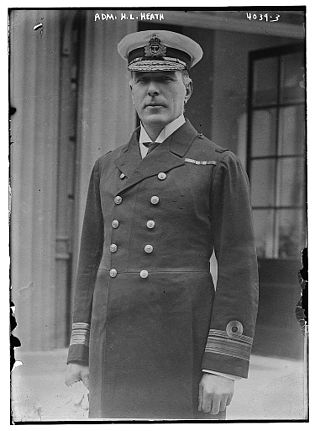
Admiral Sir Herbert Leopold Heath, was a senior officer in the Royal Navy who served as Second Sea Lord and Chief of Naval Personnel from 1917 to 1919.
Admiral Sir William Wellclose Davis was a British Royal Navy officer who went on to be Vice Chief of the Naval Staff.
Admiral Sir Kenneth John Eaton was a Royal Navy officer who served as Controller of the Navy from 1989 to 1994, as well as President of the Society for Nautical Research from 2020 to 2022.
















